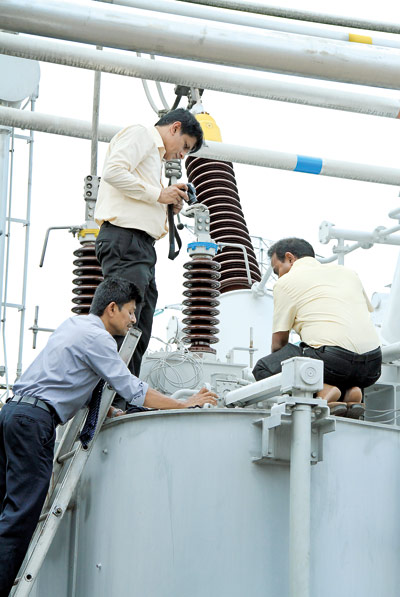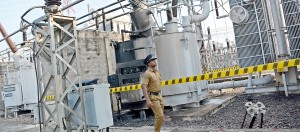News
Another power failure: CEB must switch to hi-tech professionalism

What caused the blast? A CID officer and engineers investigating the Biyagama plant. Pic by Indika Handuwala
Experts are scrambling to determine how three electricity blackouts occurred within six months and the answers are still not forthcoming. There is general consensus, however, that imbalances in the power system cannot– and must not — lead to regular countrywide shutdowns.
“There were three blackouts in September, February and March,” said Damitha Kumarasinghe, Director General of the Public Utilities Commission of Sri Lanka. “Everybody was talking about the failure of a transformer or of Norochcholai tripping or of a lightning strike. Transformers can trip at any time, lightning can occur and generators can break but the underlying principle is that the system must be stable. The system failed on all three occasions.”
The PUCSL commissioned a study of the first countrywide failure that occurred in September. It was conducted with the assistance of Canadian experts Manitoba HVDC research centre. The report took many months to produce as it was some time before the necessary data were obtained. The conclusions of the study were highly technical in nature but several shortcomings have been identified.
“You are hereby directed to design long term measures to avoid such system failures in future, after fully reviewing the system models used for both steady state and dynamic modelling,” instructs a letter sent on Tuesday by PUCSL Chairman Saliya Mathew to the CEB.
Reports into the second and third failures — they occurred in February and March 2016 — are yet to be produced. A committee appointed by the Government met sector experts this week to get their views on the recent incidents. Among the professionals interviewed was Asoka Abeygunawardana, chairman of the Sri Lanka Energy Managers’ Association.
“The recommendations made by the international consultants indicate that the CEB has inadequate data to come to a conclusion regarding what has happened,” Mr Abeygunawardana told the Sunday Times. “The first issue, therefore, is that the system stability information is not available with the CEB officials. They need to know the performance of each and every transformer, generator, and so on.”
“But the second and third failure happened since there were no proper recommendations to rectify the situation,” he said. “The discussion is to find out the root cause. If a particular power plant or transformer breaks down, there is no reason for a countrywide blackout. The system is not properly geared to avoid such a thing. If we have professionalism, adhere to proper standards and carry out maintenance work properly, such things cannot happen.”

Sub station at Kotugoda: Police guard after the blast. Pic by M.D. Nissanka
Mr. Abeygunawardana also said the functioning of the Lakvijaya coal power plant– all three units tripped each time — indicated a design fault. “There is no reason for it to shut down if it is up to standard,” he said. “That it happened to all three generators all three times implies that there is a design fault. The persons who approved the design must take responsibility.”
“To rectify the situation, we need to attend to this and make sure that the three power plants at Norochcholai maintain at least minimum standards,” he said. The fact that the Lakvijaya plant is now operational has not alleviated the risk. “There is no guarantee that if a lightning strike occurs somewhere else, these parts will not fail and it will not lead to a countrywide blackout again, particularly now as we do not have adequate hydropower. Because the Norochcholai power plant is substandard, it is responding to something else getting damaged somewhere else. We need to rectify the root cause, not just repair it and reconnect it to the grid.”
Apart from technical faults at Norochcholai, the Biyagama transformer also should not have failed had proper maintenance been done, Mr Abeygunawardana said. He suggested an “injection of professionalism” into the CEB and the possibility of “a different management setup that attracts capable experts”. He said CEB engineers could be partnered with international or overseas engineers.
“Having a 3 x 300 megawatt coal power plant is itself an issue because one large power plant increases the risk of countrywide blackouts,” he said. “What we need are a large number of decentralised, small-scale power plants to reduce the risk. That means going for renewable energy sources. And for that you need to have long term generation and transmission planning. The current planning process is not adequate.”
Mr. Abeygunawardana predicted more blackouts “if we cannot rectify the issues at Norochcholai and there is a shortage of rainfall in the Yala season”.
There must be a detailed investigation into the root causes of the countrywide blackouts, said Asanka Rodrigo, Senior Lecturer at the Department of Electrical Engineering in the University of Moratuwa. “If something happens to a power system, there will be an imbalance,” he explained. “That imbalance must be solved within a short period of time.”
“In this situation, it was not solved within a short time period,” he said. “This caused total system instability that was first picked up by Norochcholai which tripped. There was then a shortfall in power generation compared to demand. The resulting under-frequency situation caused all other power stations in the country to trip.”
“In my point of view, there can be failures in the system,” Dr. Rodrigo said. “You cannot guarantee that equipment is highly reliable and works continuously. But if a piece of equipment fails and it leads to a countrywide blackout, we cannot accept that.”
He said the CEB should have modern planning software and technologies to predict such occurrences. He questioned the accuracy of the software and technologies currently in use. “Actually, it is a shame to hear that failing in one transformer leads to a total blackout,” he said.
“You have to plan for contingencies,” Dr. Rodrigo said. “Of course, it is now dry season and there is a lack of hydropower. That is no excuse. You have to predict that kind of eventuality. The Government and the regulator must take strong action to correct this situation.”
| Major problems, but we have the solutions also: Top CEB engineerTotal power failures were a common occurrence in the not-so-distant past. There were eight countrywide power failures between 2007 and 2009. However, the CEB introduced an effective automatic stability restoration mechanism in 2010. It was called “under frequency load shedding” (UFLS). As a result there were no total failures in the six years up to September 2015, said Athula Wanniarachchi, president of the Ceylon Electricity Board Engineers’ Union (CEBEU). “Thus, due to this significant reliability improvement that our engineers have brought about, total failures have become rare occurrences and tend to draw more public attention now as a result,” he said. The answer to why system stability could not be regained speedily during recent failures is technical, Mr. Wanniarachchi said. “UFLS is effective for failures initiated by sudden tripping of large generators, which is the main cause of total power failures in Sri Lanka in the past,” he explained. “However, it is not effective for failures initiated by transmission network related faults. All three recent failures were initiated by network related causes although they led to subsequent tripping of generators.” The root cause of all three failures had their origins in the network, he reiterated. The September 2015 failure was triggered by very high network voltage, the February 2016 failure was caused by the tripping of major transmission lines and the most recent failure was once again due to the tripping of a network element, that is, the Biyagama transformer. “If you ask me whether I’m trying to justify the failures, my answer is a definite no,” Mr. Wanniarachchi said. “If you ask me whether there are no problems in the power system, my answer is yes, there are a few. But we must not think these problems are major catastrophes that are beyond our capability. Definitely, there are problems and these problems have solutions, too. That is why the engineers are there. Just as much as we have overcome problems in the past, we can overcome present ones, too.” Asked why the restoration of power took so long after the last failure, Mr. Wanniarachchi said that many in Sri Lanka thought total, countrywide breakdowns occurred only in Sri Lanka. “They are wrong. Even in the United States, failures of the size of Sri Lanka and much larger occur every few years. Restoration of some of the failures takes days, not hours like in Sri Lanka. “Restoring supply after a failure is a highly skilled job that needs training. We are good at the task and usually restore a failure within three hours. After the September 27, 2015, failure, supply was restored in four hours and during the February 25, 2016 failure, within two-and-a-half hours. “Unfortunately, during the most recent one, while the system was being restored, there was a previously unknown fault that occurred at the Pannipitiya grid substation. This caused the grid to fail twice again, even after 80 percent of power was restored,” he explained. |

